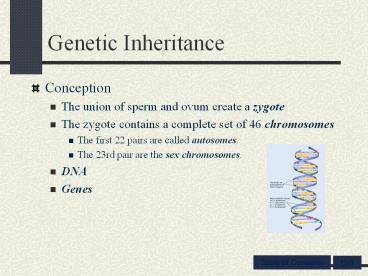Genetic Inheritance - PowerPoint PPT Presentation
1 / 16
Title:
Genetic Inheritance
Description:
Genetic Inheritance Conception The union of sperm and ovum create a zygote The zygote contains a complete set of 46 chromosomes The first 22 pairs are called autosomes. – PowerPoint PPT presentation
Number of Views:45
Avg rating:3.0/5.0
Title: Genetic Inheritance
1
Genetic Inheritance
- Conception
- The union of sperm and ovum create a zygote
- The zygote contains a complete set of 46
chromosomes - The first 22 pairs are called autosomes.
- The 23rd pair are the sex chromosomes.
- DNA
- Genes
2
Genetic Principles
- Genes
- Genotype.
- Phenotype
- Reaction range
- Alleles
- Homozygous Alleles (similar)
- Heterozygous Alleles (different)
- dominant - recessive gene principle
- incomplete dominance (blending)
- codominance (type AB blood)
3
Genetic Inheritance
- Single Gene-Pair Inheritance
- Polygenetic Inheritance
- Genetic Imprinting
- Genes are (chemically marked) in one of the
parents and have different effects depending on
which parent carries it. - Huntington disease manifests earlier if passed on
by the male - Asthma / females , Diabetes / males
4
Genetic Inheritance
- Sex Linked Genes or Traits (X-linked inheritance)
- ex hemophilia, red/green color blindness
- Mutations
- A sudden, permanent alteration in DNA
- occurs spontaneously or by environmental hazards
- Chromosomal Abnormalities
- Often the result of the 46 chromosomes not being
divided equally (too many or too few) - Down Syndrome
5
Genetics Environment
- Heritability
- The amount of variability in a population on
some trait dimension that is attributable to
genetic differences among those individuals
6
Gene-Environment Relationships
- Epigenetic View Heredity ?? Environment
- Passive Gene-Environment Relation
- Evocative Gene-Environment Relation
- Active Gene-Environment Relation
- Shared and Non-shared Experiences
7
Stages of Prenatal Development
8
Germinal Stage (Weeks 1-2)
- The zygote, begins to divide, and travels down
the fallopian tube. - The new cells form the blastocyst, which attaches
itself to the uterine wall - The blastocyst forms several layers of cells
- The outer cells (trophoblast) form the placenta.
9
Embryonic Stage (weeks 3 8)
- The inner cells of the blastocyst which will
become the embryo differentiate into three
layers - Ectoderm Outermost layer which will become
skin, hair, nails, the nervous system, and
sensory receptors - Mesoderm Middle layer which will develop
into the circulatory system, bones, muscles,
excretory and reproductive system - Endoderm Undermost layer which will develop into
the digestive and respiratory systems
10
Embryonic Stage (weeks 3 8)
- The formation of organs begins (organogenesis)
- Sexual differentiation takes place around the 7th
or 8th week - By the end of the embryonic stage about 95 of
body parts and systems have begun development.
11
Fetal Stage (Week 9-Birth)
- This period involves the dramatic increase in
body size and completion of all physical
structures - Age of viability approx. week 25
12
Prenatal Growth
- Occurs in three patterns
- Orthogenic
- Cells are all the same and then differentiate
- Cephalocaudal
- Latin for from head to tail.
- Proximodistal
- Latin for from near to far.
13
Influences on Prenatal Development
- Nutrition
- Stress
- Mothers Emotional state
- Mothers Age
- Nearly 50 of pregnancies among women in their
40s and 50s result in miscarriage. - Father
14
Influences on Prenatal Development
- Teratogans are any disease, drugs, or other
environmental agents that can cause damage to a
developing fetus. - Effects depend on
- Dose
- Heredity
- Presence of other teratogens
- Age of child
- Sensitive period
15
Postnatal (Postpartum) Depression
- Occurs in 1/10 new mothers
- Effects bonding and initial care of child
- Effects on mother
- May not want child
- Mood lability and other symptoms of depression
- Psychosis
- SI / HI
16
Postnatal (Postpartum) Depression
- Effects on child
- Susceptibility
- Past episode(s) of post partum (30 to 50 chance
with each subsequent delivery) - Personal past history of a mood disorder
- Family history of Bipolar disorder (even if not
personally experienced)

